Home »
Stellantis ProOne was created towards the end of last year to symbolise the unification of the many Stellantis brands that now exist under its commercial vehicle umbrella. Citroen, Fiat, Peugeot and Vauxhall brands are now all built off shared platforms producing an unparalleled number of vehicles. With small, medium, and large models from four brands as well as internal combustion engine (ICE) and electric powertrains, there’s 24 individual models. Now, all of them which have been refreshed in some way, simultaneously in an unprecedented renewal of their light commercial vehicle line-up.
But the models aren’t just limited to battery electric vehicles (BEV) and diesel (and some petrol) engine models. Stellantis has also been working on incorporating hydrogen fuel cells into its van range with a mid-sized van available in France and Germany since 2022. Built as a manual conversion, off the production line, the medium-size hydrogen (built as the Vauxhall Vivaro-e Hydrogen) has enjoyed a degree of commercial success but has helped inform the production of an additional model on the large van platform chassis. Due to payload and range compromises for large BEV vans, hydrogen makes considerably more sense, increasing range, reducing “refilling” time compared to EVs and maintaining payload – all while being zero emission. Despite a slow proliferation of hydrogen filling stations across Europe, a European Commission roadmap to create refuelling points within 200km of each other across the entire network of major EU roads will enable hydrogen vans to become viable for many more customers.
However, creating a hydrogen vehicle using an existing platform is not a straightforward process. Renault-owned Hyvia has opted to install its hydrogen tanks on the roof for its first-generation van in an effort to become first to market with a large fuel cell LCV. While the next generation Renault Master (deliveries for which will begin later this year) will enable hydrogen fuel tanks to be incorporated into the chassis, Stellantis have managed to modify the configuration of their mid-sized van’s fuel cell system into the larger model thanks to its renowned ability to work for conversions – largely in the campervan segment.
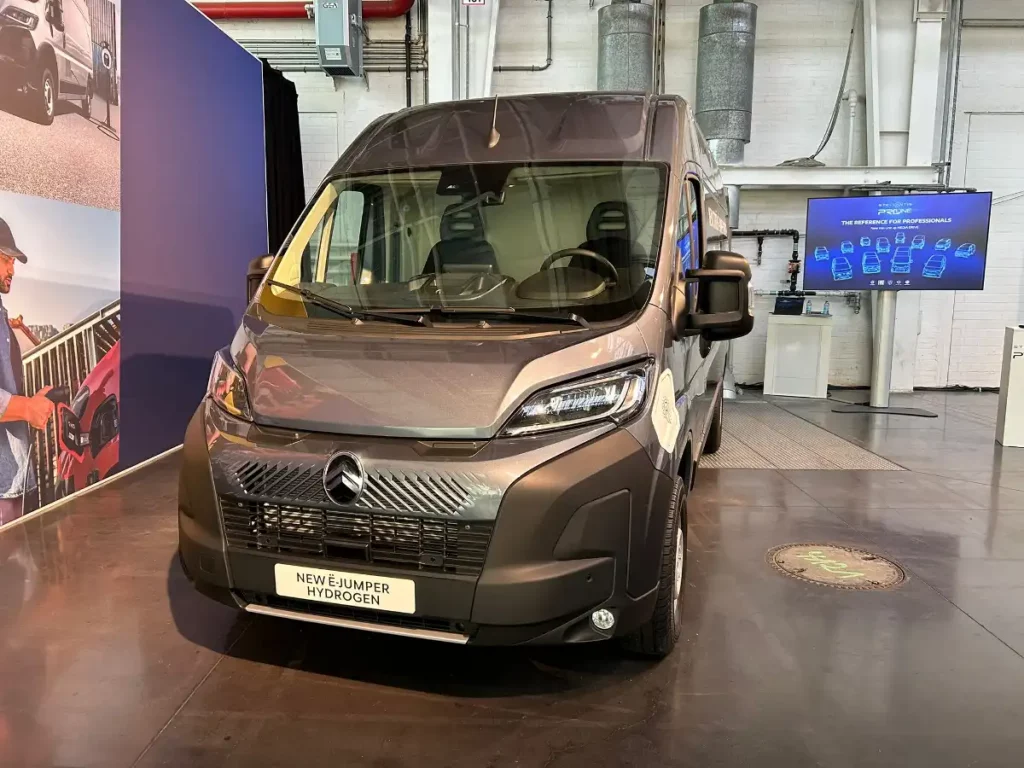
“The installation of the fuel cell system was more challenging than in the mid-sized van,” explains Stellantis hydrogen programme chief engineer, Peter Gross.
“The large van in terms of interior to exterior dimension is best in class, there’s’ nearly no empty packaging space left, so that is why the package looks quite different to the medium-sized van,” he explains.
While both medium and large vans are based on their BEV siblings. The large hydrogen vans will be available using the Citroen E-Relay platform, as well as the Fiat E-Ducato, Peugeot E-Boxer and Vauxhall Movano Electric. The medium van hydrogen fuel cell is based on the Citroen E-Dispatch, Fiat E-Scudo, Peugeot E-Expert and Vauxhal Vivaro Electric, all of which used the space under the bonnet to stack the fuel cell on top of the electric motor used to drive the front wheels. Gross explains that in the larger version this didn’t work, prompting his team to look elsewhere. They opted to use the location previously utilised by the large van’s diesel tank, located under the front seat.
“Package space was found under the front seat, there is a large diesel thank that has been removed and with some modification of the sheet metal there was a chance to put the high voltage battery and the fuel cell stack into this space.”
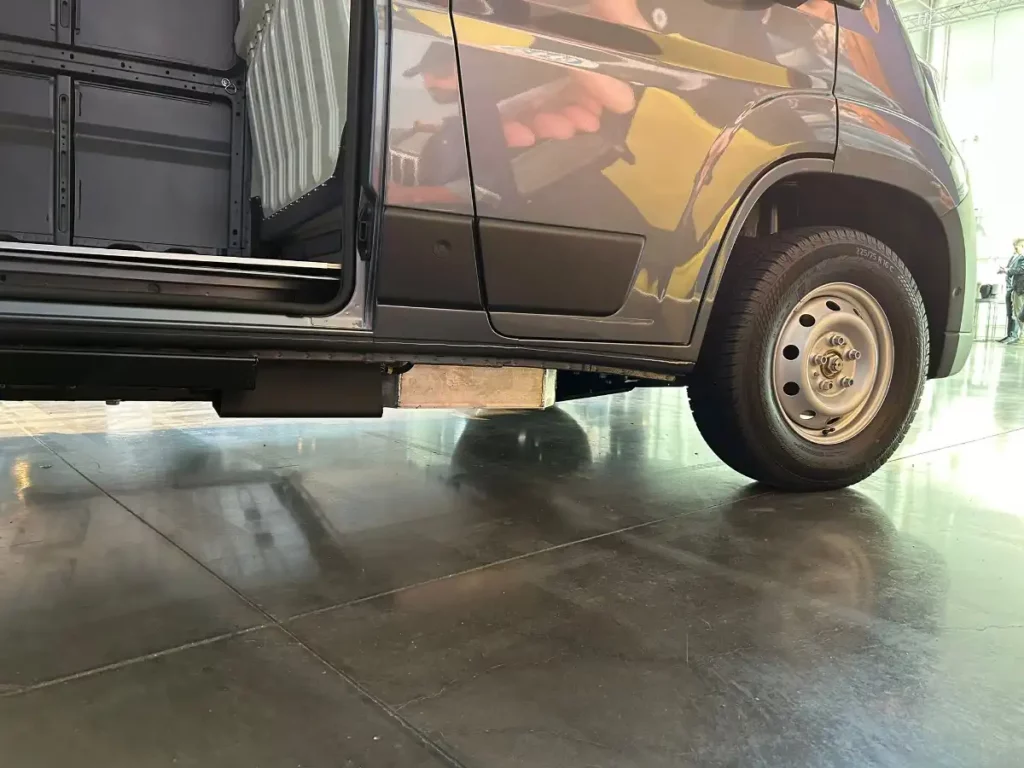
The new location has mean that the air filter now sits in the front of a van, feeding air to a cathode just behind it that is linked by pipework to the fuel cell under the seats. Hydrogen is then fed into the fuel cell from the tanks located in the rear of the van between the chassis rails. Power is then either used for propulsion or stored in the battery underneath the fuel cell. Apart from the layout, there’s also one other significant difference between the medium and large vans.
“In the mid-sized van the battery was actually in the interior of the vehicle, but in the large van it’s in the floor with the other [components],” Gross explains. The result is an easier and more logical installation that, unlike the medium-sized van, will enable the large hydrogen van to come as a right-hand-drive van as early as next year. Unfortunately, the same isn’t true of the mid-sized van. Despite Stellantis launching the van more than a year ago and having moderate success in France and Germany – two countries with a relatively established network for hydrogen refuelling – it is only now just being rolled out to additional markets. The Netherlands, Belgium and other countries in western Europe all feature on the product plan, however, the UK will not for this generation of vehicle. Gross says that it will take a few years for the medium van to be available in right hand drive with a fuel cell, which will be for the next generation of van.
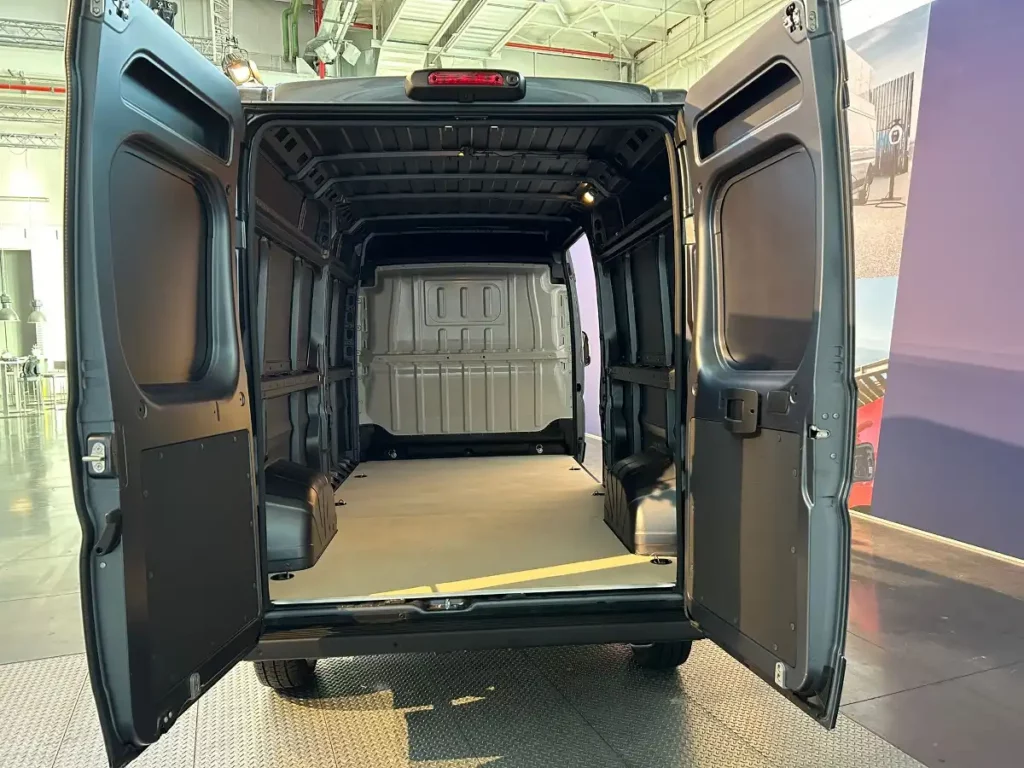
On the other hand, the large van was “considered from the very beginning” according to Gross due to our well-developed home delivery and courier services. While the UK doesn’t have a public infrastructure capable of supporting private use of hydrogen fuel cell vehicles, Stellantis is clearly expecting some private businesses to invest.
“It’s well known that the UK is very open to alternative fuels and the fuel cell proposition,” Gross explains.
“The medium van, will not come as right hand drive in the next few years. It will come with the next generation. Physical constraints are always an issue if you take an existing vehicle and want to install fuel cell components you have to live with certain restrictions,” he adds.
Despite no right-hand-drive hydrogen medium vans, Gross says they’re growing in popularity. They’ll also greater visibility later this year when being used as passenger vehicles around Paris during the Olympics.
“The market demand is growing, and it’s important to have these products available to give customers options. There is no other OEM offering mid-size and large hydrogen vans. With the European Highway, the door will be open to use these vehicles all over Europe,” Gross says referring to the EU’s hydrogen road map.
With hydrogen uptake and infrastructure being such a chicken and egg scenario, building a viable product is the best solution manufactures can have. That’s why Gross says considerable effort was made to ensure that as much hydrogen was able to be carried as possible. The addition of a fourth tank, compared to the medium van’s three, makes the large van a much more usable prospect for the fleets that are likely to be the primary buyers. That capacity, however, was only possible due to the large van’s innate ability carry payload. Luca Marengo, Stellantis commercial vehicles head of global product, attributes that to the van’s design and long standing success as a converted vehicle.
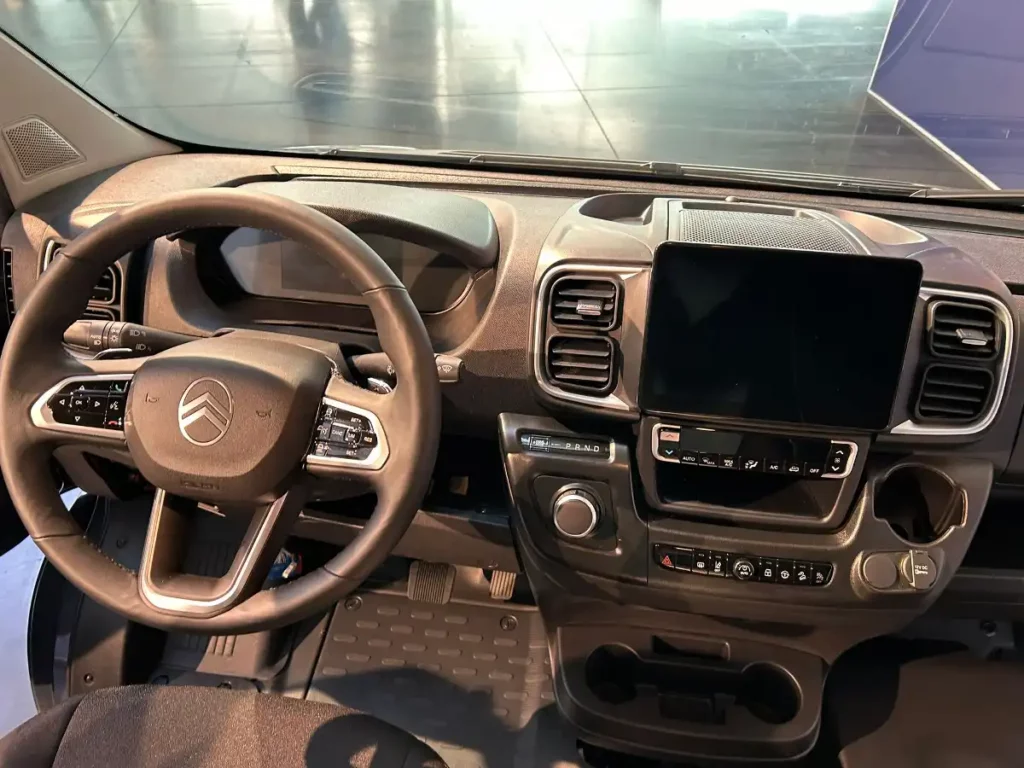
“The Ducato and these [large Stellantis] vans have always been popular with conversions, particularly motorhomes. Storing clean and waste water is something they have always done. That has helped with the space in the chassis for the hydrogen,” Marengo explains.
Ultimately the market will decide how much of a success hydrogen vans will become, but with large vans and fleet customers, they stand a fighting chance. The scalability of the design will also help with a powertrain used across medium and large vans, there’s hope that like electric motors and modular battery packs, volumes will reduce the price and bring hydrogen to the mass market.
Stellantis ProOne’s new hydrogen large van will come in right-hand-drive as early as next year.
Unlike the mid-sized version of their hydrogen fuelled van – currently available in France and Germany as the Vauxhall Vivaro-e Hydrogen – the large van will be based off the Citroen E-Relay, Fiat E-Ducato, Peugeot E-Boxer and Vauxhall Movano Electric battery electric vans. It uses a combination of a 110kW motor paired to a 45kW fuel cell with an 10.5kWh battery pack.
Hydrogen storage is from four vessels providing a total of 7kg of usable H2 and an expected range of more than 500km.
In comparison, the mid-sized van uses three vessels to give the van a 400km range.
The van will be available in L3H2 and L4H3 sizes giving a total loadspace of 13m3 and 17m3 as well as a 1,300kg payload.
The large van can be fuelled at 700 Bar enabling a fill-up time of less than five minutes.
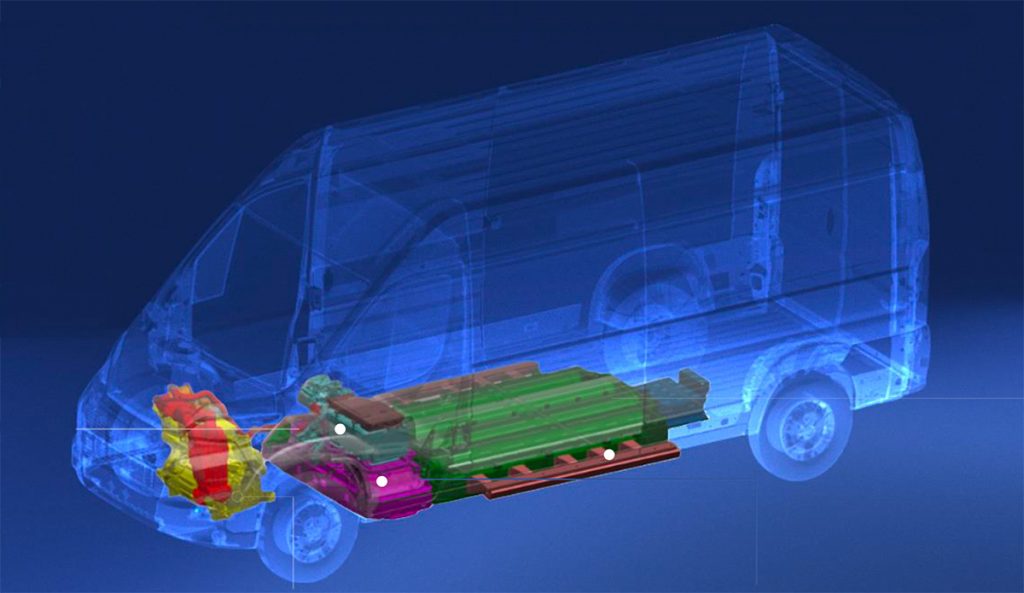
Stellantis’ decision to increase their efforts into hydrogen products are reflected in the EU Council’s decision to create the Alternative Fuels Infrastructure Regulations (AFIR). All EU countries will be required to deliver a viable hydrogen refuelling network with one 700 Bar hydrogen station located every 200km on all main corridor routes. They will also have to have 1 station for each assigned urban node in order to aid refuelling in cities. EU countries will need to have completed the network by 2030 which should create more than 500 filling stations across the EU member states.
Currently there are around 150 public H2 filling stations with the majority in Germany, France, Netherlands and Switzerland.
While the mid-sized H2 van is scheduled to be rolled out to more European countries this year, including Netherlands and Belgium, a right-hand-drive version for the UK will not come until the next generation of medium sized vans is introduced in several years time. Instead, the large van will be rolled out across Europe and to North America after 2025 when a hydrogen fuelled pick-up truck – under the RAM brand – will also be brought to market.
First Hydrogen will host its inaugural track day event aimed at major UK fleet managers. The unique event will serve as a platform to unveil First Hydrogen's hydrogen fuel cell vehicles (FCEVs) and will take place at the HORIBA MIRA track near Coventry, UK.
Scheduled for the end of October, the event will see participation from approximately 20 UK fleet operators, collectively overseeing more than a quarter of a million fleet vehicles. First Hydrogen aims to provide an exclusive opportunity for attendees to test drive the company's hydrogen-powered light commercial vehicles (LCVs) on the track. The 3.5-tonne large van, a first of their kind, will be available for hands-on experience, accompanied by technical presentations and an in-depth vehicle walkaround to showcase the advanced technology beneath the hood.
First Hydrogen has already garnered attention by conducting road trials with notable entities such as fleet management company Rivus and energy giant SSE. The fuel cell electric vans are currently engaged in operations with major parcel delivery companies. With over 15 major fleet operators eagerly awaiting their turn to trial these vehicles, the track day event at HORIBA MIRA offers a consolidated opportunity to showcase the capabilities of First Hydrogen's vehicles to a diverse range of organizations in a single day.
The event is strategically designed to demonstrate key features, including an impressive range exceeding 630km (400 miles) on a single refueling, ease of driving, and the efficient powertrain technology enabling the vehicles to carry substantial payloads without compromising range, regardless of weather conditions.
Anticipating widespread interest, the invitation-only event targets major UK LCV fleet operators, including members of the UK Aggregated Hydrogen Freight Consortium (AHFC). The AHFC, led by Element Energy with collaboration from global industrial members of UK H2Mobility, is dedicated to expediting the commercial deployment of FCEVs and hydrogen refueling infrastructure to decarbonise high-mileage and heavy-duty van and truck fleets.
First Hydrogen is set to launch fleet trials for its hydrogen-fuel-cell-powered vehicle (FCEV) in response to mounting interest from parcel delivery companies.
Following successful preliminary fleet tests amongst UK operators, the company's proof-of-concept demonstration vehicles are will undergo evalutaions with several parcel delivery firms in the latter part of Q3 and throughout Q4 of this year.
Previously, First Hydrogen predominantly catered to sectors like utilities, necessitating emission-free vehicles capable of extended travel distances and heavier loads. The current challenges confronting parcel delivery firms have prompted them to explore alternative zero-emission technologies. Although parcel couriers typically do shorter journies, from local hubs to end users, they are progressively undertaking longer routes from distribution centers to collection lockers and stores. The need for adaptable emission-reducing solutions is therfore becoming more necessary.
First Hydrogen's engineers emphasise that while these vehicles are engineered for long-haul journeys, they have been outfitted with hybrid engines (hydrogen fuel cell and battery), optimised for shorter urban routes. The incorporation of regenerative braking also assists in recharging the battery, especially during stop-and-start journeys.
An additional advantage is the rapid hydrogen refueling, which significantly reduces vehicle downtime compared to electric vans. Refueling First Hydrogen's light commercial vehicles takes around 5 minutes. Hydrogen vans can therefore have extended daily operational cycles, enabling vehicles to remain on the road for longer.
Steve Gill, CEO of First Hydrogen Automotive, said: "The mounting pressure to reduce carbon footprint, coupled with the emergence of low and zero-emission zones in urban areas and the phasing out of petrol and diesel vehicles, positions hydrogen mobility as a pragmatic solution for the challenges confronting last-mile delivery operators. Fleet managers are recognizing that relying solely on battery electric vehicles (BEV) may not suffice to meet the reliability and operational adaptability needed to meet customer demands. Future fleets should integrate both BEV and FCEV to surmount these hurdles and achieve net-zero targets. The expansive and expanding parcel delivery sector is in dire need of environmentally sustainable and economically viable fleets, and our hydrogen-powered light commercial vehicles hold the potential to fulfill this demand. This presents us with an exciting prospect to tap into a new customer base, further expediting business expansion and potentially expediting our vehicle's market entry."
Ford is leading a research project to investigate the potential for a hydrogen E-Transit as an onboard energy source for its Ford E-Transit van, with the aim of establishing whether fuel cell technology can provide greater zero-emission range to heavy-use customers who travel high mileages with maximum loads, ancillary equipment such as chillers, and limited charging opportunities in their working shift.
The project is part-funded by the Advanced Propulsion Centre (APC) and involves a consortium of six automotive technology leader and fleet operator partners who will help to determine the supporting hydrogen refuelling infrastructure required.
The project will also expand Ford Pro's conversion expertise, with engineers and E-Transit specialists from Dagenham and the company's nearby Dunton Technical Centre in Essex providing support. The project will validate the vehicle's business case by linking Ford's expertise as a 57-year UK van market leader with fuel cell powertrain experts and fleet operators including Ocado Retail.
Other partners on the project are bp, capturing hydrogen usage and infrastructure requirements; Cambustion, testing the fuel cell system; Viritech, designing hydrogen storage systems; and Cygnet Texkimp, providing the pressure vessels’ carbon fibre tooling.
Tim Slatter, chair of Ford in Britain, said: “Ford believes that the primary application of fuel cells could be in its largest, heaviest CVs to ensure they are emission-free, while satisfying the high daily energy requirements our customers demand.
“Ford has an unmatched history in the commercial vehicle sector with the indomitable Transit, and we are excited to be exploring new ways to make clean deliveries an option for even our hardest working vans on the road.”
A low-volume test fleet of eight hydrogen fuel cell Ford E-Transit vans will run for six-month periods over the three-year project to 2025. Test fleet data will provide insights into the total cost of owning and operating a large van, with increased range and operating hours to match its diesel-powered equivalent and without the need to charge.
The prototype Ford E-Transits will be fitted with a high-power fuel cell stack, in conjunction with significant hydrogen storage capability, optimised for safety, capacity, cost, and weight. An important project element will evaluate efficient and viable recycling for end-of-life components

A brand new hydrogen-powered van from Vauxhall will make its debut at the Commercial Vehicle Show in Birmingham. The Vauxhall Vivaro-e Hydrogen is currently only earmarked for left-hand-drive markets by the end of this year, however, UK customer will be able to get one, eventually.
The hydrogen Vivaro will reach the UK in right-hand-drive in early 2023.
It has a hydrogen fuel cell system located in the van's engine bay that is said to give it a range of 249 miles. Refuelling the Vauxhall Vivaro-e Hydrogen will take as little as three minutes.
One of the main highlights of the hydrogen Vivaro is that it will still have the same storage capacity as the regular van with a load volume of up to 6.1m3.
There's no word on price yet, and Vauxhall says it is speaking to corporate fleets ahead of its UK launch - that will probably mean that it will be expensive, but 2023 is still a long way off.
Read our Vauxhall Van Reviews
Also revealed to the public for the first time at a motor show were the two new all-electric vans in the Vauxhall range.
The small electric van Vauxhall Combo-e was joined by the Vauxhall Movano-e large electric van.
Read our Vauxhall Vivaro-e Hydrogen review
The show is the first opportunity to see the new models in the metal as Vauxhall makes steps to electrify its entire range, an accomplishment it has now achieved with its commercial vehicle range, and hopes to follow the huge success of the Vauxhall Vivaro-e launched in 2020.
The large Movano-e has a load volume of up to 17m3 and has a claimed range of up to 139 miles, while the small Combo-e has a volume of 4.4 m3 with a range of 171 miles from a 50kWh battery pack.
Also on display was a Vauxhall Vivaro-e Platform Cab Concept, built in collaboration with Paneltex the concept targets supermarkets and retailers who are looking at home delivery in urban areas.